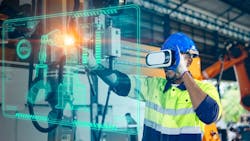Manufacturing minute: 4 must-read articles on metaverse-powered manufacturing, Keen’s robotic boot factory, and more
Every minute counts in manufacturing—especially when you're chasing uptime, efficiency, and performance. That’s why we created Manufacturing Minute, a curated snapshot of articles worth your time. From real-world reliability wins to smart maintenance practices, we’ve got you covered. Here's what’s trending across the industry this week.
14 Years Ago, Steve Jobs Explained Why iPhones Can’t Be Made in America. It’s Worth Revisiting Today
Author: Jessica Stillman
Source: Inc.
60-second snapshot: This article revisits Steve Jobs’ 2011 assertion that iPhones cannot be manufactured in the U.S., a view that remains relevant amid ongoing political efforts to revive American manufacturing. Jobs cited not only cost but also the unmatched speed, flexibility, and skill of overseas labor as key reasons for Apple’s reliance on foreign factories. Despite public support for more domestic manufacturing, surveys reveal that few Americans want these jobs themselves, and the U.S. still lacks the supply chains and technical skills to support such production. The article underscores that any serious revival of U.S. manufacturing must begin with a clear-eyed understanding of these systemic challenges.
Learn more
The Dream of the Metaverse Is Dying. Manufacturing Is Keeping It Alive
Author: Nicole Kobie
Source: WIRED
60-second snapshot: While the consumer-focused vision of the metaverse has struggled, the industrial metaverse is thriving, transforming how manufacturers like BMW design and operate factories through virtual simulations and digital twins. Tools such as Nvidia’s Omniverse enable detailed modeling of production lines, allowing engineers to test and optimize processes before physical implementation, saving time and reducing costly errors. This digital transformation bridges physical and virtual worlds using spatial computing, with applications extending from virtual reality training to AI-driven automation. As robots and autonomous systems evolve, the industrial metaverse is poised to be a foundational technology shaping the future of manufacturing.
Learn more
At a new factory in Kentucky, robots will help make your Keen boots
Author: Adele Peters
Source: Fast Company
60-second snapshot: Keen is opening a new, highly automated factory in Kentucky to produce its American-built work boots using robots and advanced manufacturing techniques like direct injection fusing. This move follows more than a decade of domestic production in Portland, Oregon, which is now winding down due to labor challenges and scaling needs. Despite higher production costs in the U.S., the company sees benefits in faster response to demand, lower shipping emissions, and strong customer preference for domestically made products. However, Keen acknowledges the long-term challenges of rebuilding a U.S.-based supply chain and labor force, calling for government support such as eliminating tariffs on components.
Learn more
Cybersecurity Blind Spots Put Manufacturers at Risk as They Modernize
Author: Rob Gurzeev
Source: IndustryWeek
60-second snapshot: As manufacturers digitize operations, many are unknowingly exposing industrial control systems (ICS) and SCADA networks to the internet—systems originally designed to be isolated. This creates critical cybersecurity blind spots that traditional tools often miss, leaving key assets like PLCs and HMIs vulnerable to attack. The article urges a shift to an "outside-in" security approach that mirrors hacker tactics, identifying hidden exposures across all business units. Without this perspective, modernization efforts could backfire, leading to safety risks, downtime, and regulatory penalties.
Learn more
How manufacturers are closing high-skill gaps
Author: Aaron Merkin
Source: Smart Industry
60-second snapshot: Manufacturers are turning to AI to address a growing shortage of high-skill workers, with nearly 2 million jobs projected to go unfilled by 2033. Tools like predictive maintenance, data analytics, and real-time monitoring allow companies to extend the capabilities of less-experienced workers and improve operational efficiency. Most manufacturers now use AI to support skilled roles, reduce equipment failures, and optimize workflows, particularly in the absence of expert talent. Rather than replacing humans, AI acts as a co-pilot, enabling existing teams to do more with fewer resources and helping manufacturers stay competitive in a rapidly evolving industry.
Learn more
About the Author
Alexis Gajewski
Senior Content Strategist
Alexis Gajewski has over 15 years of experience in the maintenance, reliability, operations, and manufacturing space. She joined Plant Services in 2008 and works to bring readers the news, insight, and information they need to make the right decisions for their plants. Alexis also authors “The Lighter Side of Manufacturing,” a blog that highlights the fun and innovative advances in the industrial sector.
